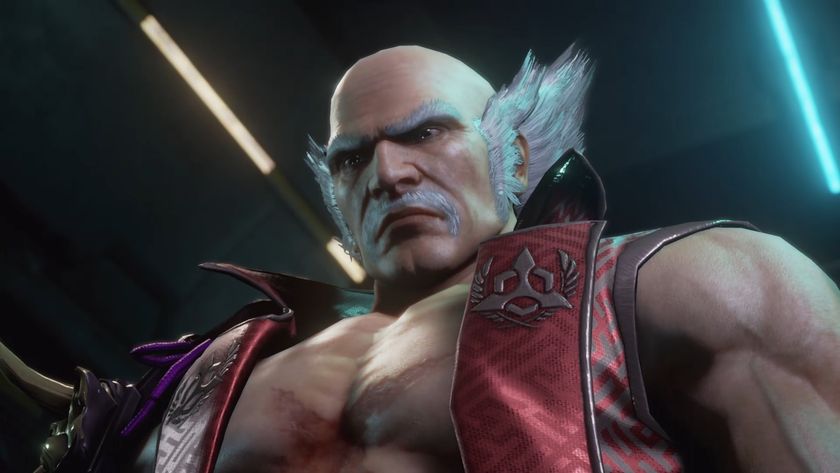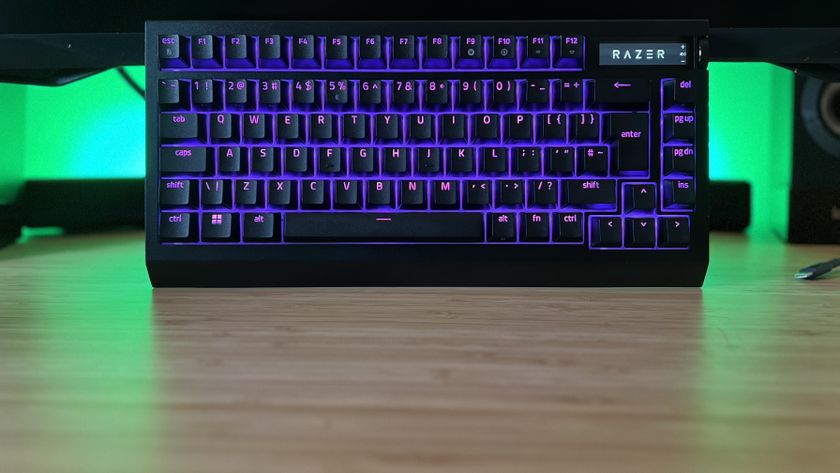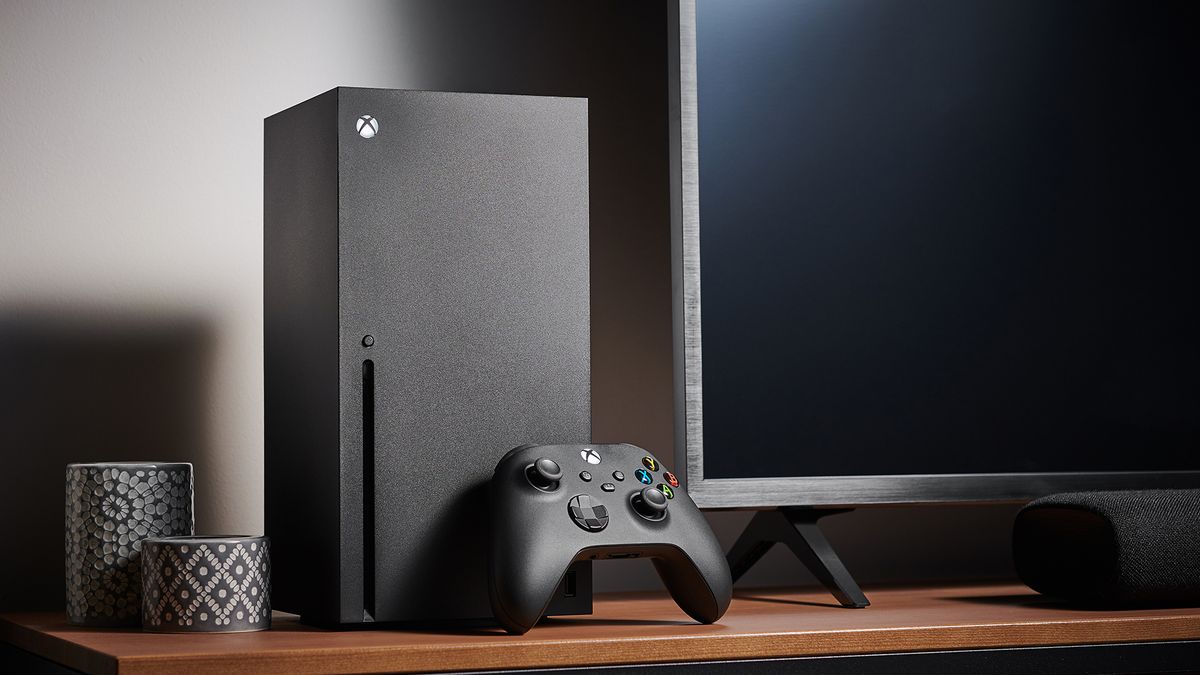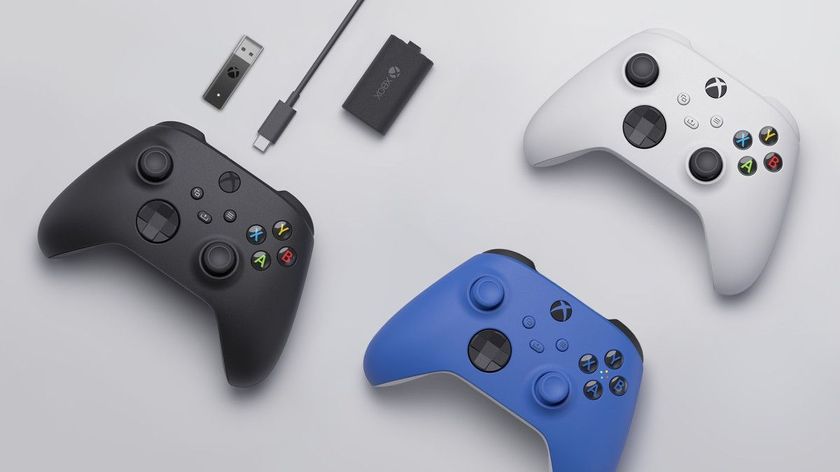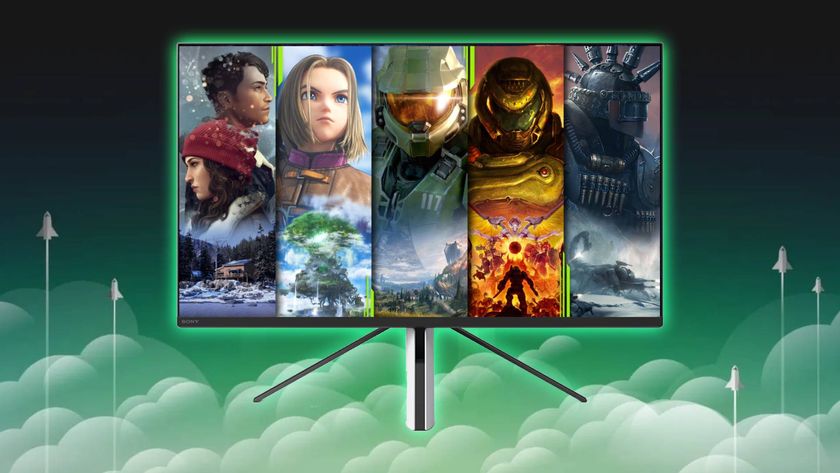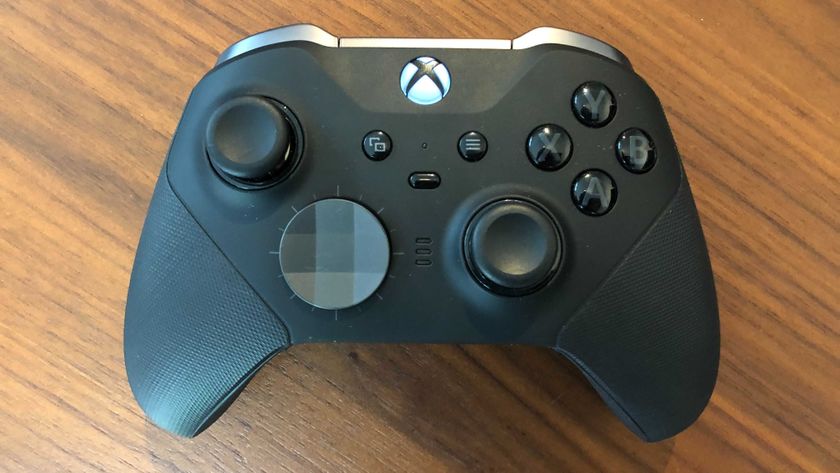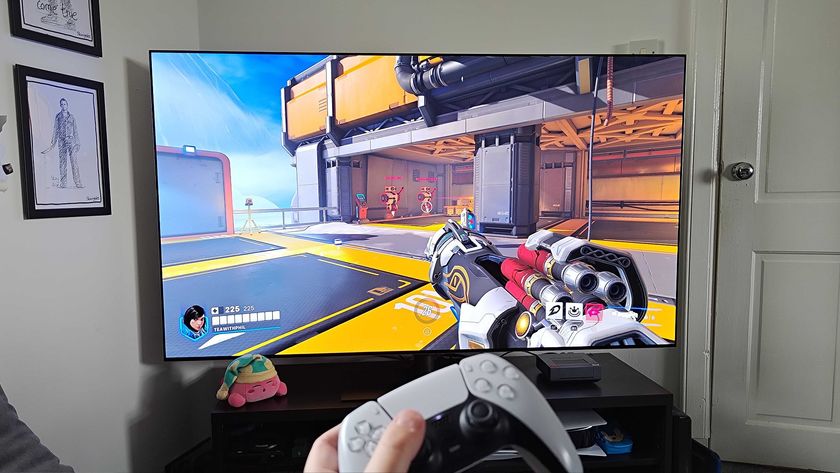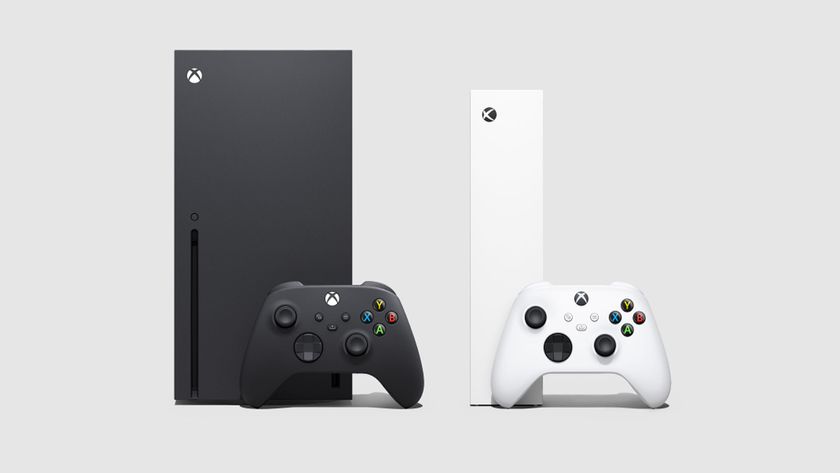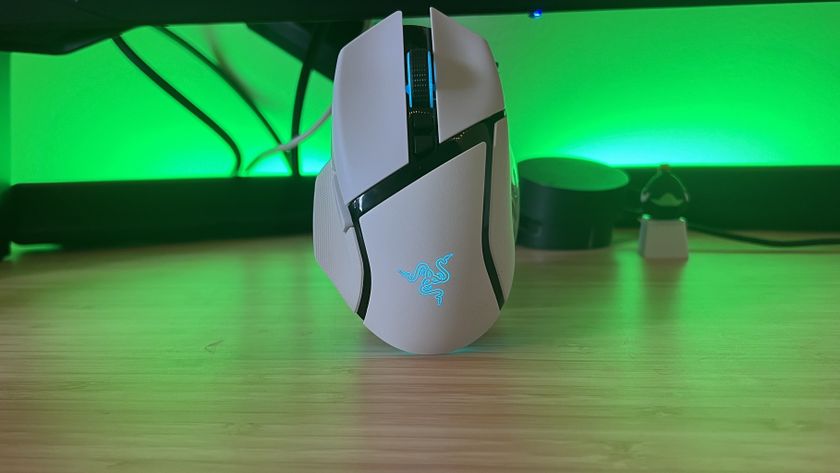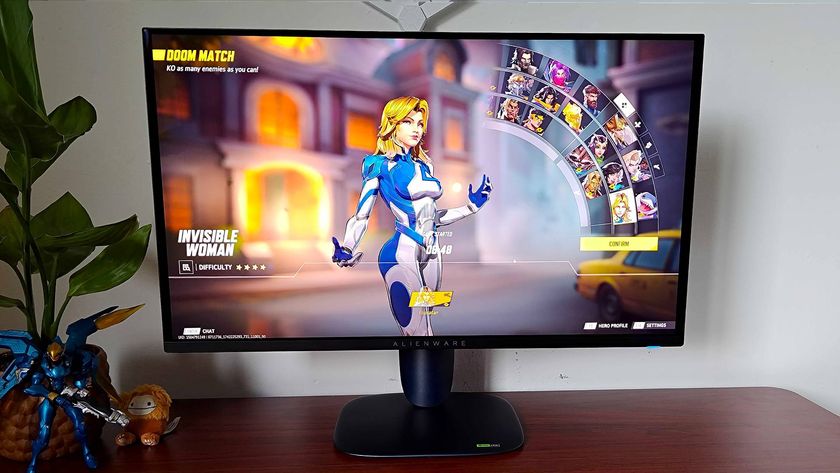12DOVE Verdict
The Xbox Series X is a great console with only a few games on the immediate horizon designed to take full advantage of it.
Pros
- +
Excellent performance
- +
Great backwards compatibility
- +
Quiet, cool, and powerful
Cons
- -
Lacks showcase games
- -
User experience is very familiar
Why you can trust 12DOVE
The Xbox Series X is looking to have an excellent year in 2023. That's mainly down to the sheer number of Xbox exclusives among the various upcoming Xbox Series X games confirmed to launch this year.
Thankfully, Xbox Series X stock issues have now mainly resolved themselves, which means that it's a great time to learn more about Microsoft's latest console. Whether you're the proud new owner of one yourself, or you're trying to decide whether or not to make that purchase, this article has everything you need to know about the Xbox Series X.
Where to buy
US
Amazon: often price matches on controllers, headsets, and more
Best Buy: accessory bundle deals often include Game Pass
CDKeys: big discounts on a massive range of games
Microsoft: All Access purchase options and big accessory savings
Newegg: regular bundle deals with free games
Walmart: best for budget third party accessories and cheap games
UK
Amazon: regular discounts on games and accessories
Argos: best for budget controllers and accessory bundles
CDKeys: big savings on old and new games
Currys: stock drops regularly include Game Pass bundles
Microsoft: regular discounts on controllers and accessories
Very: console bundles often stay in stock longer
Original review (November 2020)
You shouldn't think of the Xbox Series X as an evolution of the Xbox One that launched in 2013. Always listening, frequently watching, and rarely responding as you believed that it should or hoped that it could – Microsoft abandoned it and the battle for input one long ago. It's better to think of the Xbox Series X as an iteration of the Xbox One as it exists today, and as a continuation of the ecosystem that has flourished around it.
The Xbox One was originally positioned as a mainstream portal for entertainment. It was born out of a perception that players were spending more time watching media on Xbox 360s than they were playing games. Let that be a miscalculation that will live on in infamy; where the Xbox 360 never let a burgeoning infatuation with streaming services diminish the quality of games at the heart of its experience, the same could not be so easily said of the console that followed. It has taken countless revisions of the user experience and three major hardware overhauls to get Microsoft here in one piece.
Instead of treating the next generation as an opportunity to start anew, as Sony is doing with the PS5, Microsoft has positioned the Xbox Series X as the next stage of an endeavour that began in earnest back in 2017. That was the year Microsoft attempted a drastic return to the values that were once synonymous with Xbox: power and performance, leveraged to create the best environment for you to play. Kinect was laid to rest, the dashboard received its Windows 10-inspired Fluent Design update, and the Xbox One X made its debut alongside Xbox Game Pass. The Xbox Series X has been engineered alongside each of these developments.
The Xbox Series X doesn't represent the closing of a book then, but the beginning of a new chapter. There's an inherent familiarity to the hardware, the user experience, and the games arriving alongside this console on November 10. And despite all of this, the Xbox Series X is still able to establish a strong foundation for the future. Where Sony has decided to use its next-generation console to upend the industry, Microsoft is continuing to lay the groundwork for what could come in the years ahead – a powerful platform that is capable of making Xbox the best place to play once again.
XBOX SERIES X HARDWARE AND DESIGN
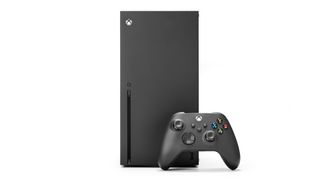
The Xbox Series X casts a commanding silhouette. It's a monolithic slab of matte black plastic that stands 11.8 inches tall, 5.9 inches deep, 5.9 inches wide, and weighs in at 9.8 pounds. On its face, you'll find a pairing button that handily conceals an IR receiver, a 4K UHD Blu-ray optical drive, a USB 3.1 Gen 1 port, and an Xbox logo power button that lightly glows white while you play.
While the Xbox One was built to fade into the background of your home entertainment centre, the Xbox Series X is designed to quietly dominate it. If you can find a suitable place to stand it (and it is clearly meant to be used vertically, a fact that is reinforced by the fixed orientation of the Xbox logo and the non-removable stand), it'll soon feel like another fixture – not unlike that of a (more visually appealing) PC tower. The Series X doesn't draw attention to itself, like the provocatively designed PS5; an angular mass complete with pulsing strips of blue lighting that seems purpose-built to attract the eye.
Xbox One owners will notice that some connectivity options have been lost in the transition to the next generation, although this largely reflects the shift away from ambitions in the entertainment space. HDMI-In pass-through is out, as is IR-Out and the optical audio connection. As part of Microsoft's ongoing commitment to promoting accessibility, there are tactile Braille indicators above each of the rear ports – two additional USB 3.1 ports, a gigabit Ethernet port, a storage expansion slot, and HDMI 2.1-Out. I do have concerns over future-proofing efforts with respect to connectivity. The PS5 comes equipped with USB-C, and it arrives with Wi-Fi 6 support whereas the Series X has stuck with an 802.11ac wireless networking solution; only time will tell how impactful these omissions will be.
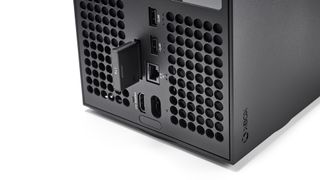
The Series X is equipped with a high-speed 1TB NVME SSD with 802GB of available storage – an improvement over the 780GB of usable space on an Xbox One X. The SSD unlocks the true potential of the system, allowing for faster load times and impressive new features such as Quick Resume – which will let you swap between multiple games that are held in a suspended state in fewer than 10 seconds. HDMI 2.1 is also a key component of the console, allowing for new performance and latency-reducing innovations for home console such as Variable Refresh Rate (VRR) and Automatic Low Latency Mode (ALLM), as well as the option for compatible games to run at 120 frames per second on supported televisions.
Even with all of these system-intensive features in play, I have been pleasantly surprised to find that the console runs quietly and efficiently, even after lengthy sessions with games optimised for Xbox Series X. The console also runs considerably cooler than the Xbox One X, although there is clearly some expectation that owners will think carefully about where they place the Xbox Series X so that air is able to flow unimpeded from behind the console and up through the curved venting array that sits at the north end of the console.
From a purely aesthetic perspective, I think the Series X is a better-looking console than the PS5. That's a debate that will rage for years to come, but there's something to the minimalistic nature of the Series X that speaks to me. I'm impressed with how much Microsoft has been able to pack into the box, and how efficiently it is able to run while subjected to multi-hour play sessions.
XBOX SERIES X CONTROLLER
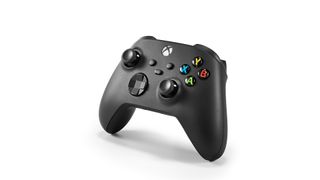
Microsoft hasn't changed the basic layout of the Xbox controller in 15 years, and for good reason – the Xbox 360 gamepad is still considered by many to be the gold standard. As a testament to its enduring legacy, Microsoft has opted to leverage small iterations on the Xbox One gamepad that leave a large impact. Adjustments have been made by the millimetre to ensure that it is a better fit for your palms. The grips have been resculpted and reweighted, with a balance born out of that decision that stands up to the scrutiny of lengthy play sessions. As does the gentle, tactile textured effect that has been applied to the top and back of the matte-black chassis.
The bumpers have been comfortably reangled for the Xbox Series X controller, while the analogue triggers have been given a little trim too. They are ever so slightly deeper, requiring a little more force than before to achieve a full depression – a key differential as developers look towards dialling in greater precision and intuitive control in this generation. The Xbox Series X controller also comes equipped with a new and easy to reach Share button, improved analogue sticks, and a new hybrid directional pad.

The Impulse and Rumble motors house within the triggers and grips of the chassis return, although they have not been improved. With the PS5's DualSense controller, Sony has gone all-in with haptic feedback and the results are a bold evolution over what Microsoft had in place throughout the last generation. It's disappointing to find that Microsoft hasn't iterated upon this technology – which is capable of delivering context-sensitive haptic feedback right to your fingertips – as it remains one of the most impressive and underutilised parts of the package. As we enter an era where how games feel is going to be more important than how they look, it's easy to wonder whether the decision not to push rumble forward will be a mistake Microsoft attempts to correct in the future.
Battery life has been an ongoing concern on Xbox One; say what you will about Kinect, but I miss its ability to detect inactivity and drop the controller into a low-power mode dearly. Expect around 30 hours of play out of standard AA batteries, although using the 3.5mm port for a headset will reduce that estimation. While you can still tether the controller to the console via USB to disable its wireless connection, you shouldn't do in service of latency reduction: the Xbox Series X controller is fast and responsive, more so than any Xbox controller that has come before it. The Xbox Series X controller is among the most comfortable and capable gamepads I have ever used.
XBOX SERIES X USER INTERFACE
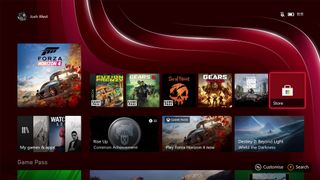
The Xbox One dashboard underwent so many revisions that it often felt as if it were in a perpetual state of beta. It has been heavily scrutinised and revised over the years, and Xbox Series X launches with what is perhaps the best Xbox dashboard to date as a result. It's flexible and fast, designed to let you navigate high-traffic areas of the dashboard with ease and shift the elements that slow you down out of your way.
While the user interface may look aesthetically identical to what is currently available on Xbox One, the speed and responsiveness make it effectively unrecognisable. The console takes fewer than 20 seconds to go from a full shutdown to the dashboard, and just a fraction of that should you have the Instant On startup mode activated. Once you're onto the dashboard, navigating between the various sections of UI and Guide has been made as frictionless as the Fluent Design will allow.
The dashboard can be customised to introduce specific blocks for your most-played games and entertainment apps, or used to pin different elements of Xbox Live to the landing page to cut down on friction – specific Friends, Clubs, Communities, and even services like Xbox Game Pass. That customisation also extends to the Guide, where you are able to reorder the tabs to prioritise access to Achievements, Capture & Share, People, Parties & Chats, and Profile & System settings.

The Guide remains the best element of the Xbox user experience. From it, you're able to do everything from start parties with friends or create Looking for Group posts if you're keen to make some new ones. You can manage the audio of your headset and microphone, check the progress of installs and updates, and dial into game capture. You're able to keep tabs on recently earned Achievements and see how close you are to completing others, and even retain access to recent notifications, the store, and more. You're able to do all of this no matter what you're doing with the console – in the middle of a game, watching a movie, tooling around on the dashboard while you wait for friends to come online. There's a hell of a lot of functionality hiding behind the Xbox button of the controller.
The biggest addition to user experience is the introduction of Quick Resume. This feature will let you jump between four-to-five games that are stored in a suspended state in the NVME memory of the SSD, meaning that you can resume playing from the place you left off in around 10 seconds. Your progress is saved even if you power the Series X or introduce physical media into the equation, it makes resuming play sessions faster than ever before. Sadly, there's no way to track what games are currently active in Quick Resume; I've been using Guide customisation to create a pinned group of games that I'm 'Now Playing' so that I can quickly jump between games I have in rotation without skipping a beat, but it's an inelegant solution to a problem that Microsoft should have anticipated.
The Xbox Series X has clearly benefited from a dashboard and accompanying user interface that has been so heavily iterated upon over seven years, although some will undoubtedly be disappointed that it's so familiar. The PS5 arrives with a brand new UI and new functionality will always be worthy of a little fanfare. Still, the Xbox Series X user experience is fast and frictionless, and your mileage with it will likely depend on whether you ascribe to the notion that 'new is always better'.
XBOX SERIES X SETUP
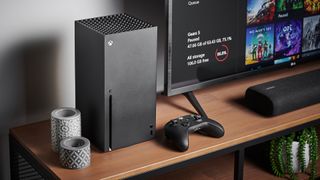
If you are turning on an Xbox Series X from a complete, powered-off state you should expect the startup to take around 20 seconds from pressing the power button to being signed into Xbox Live. If you have the Instant-On power mode enabled, that startup sequence will take between two and four seconds. From there, any of the games you previously had in a Quick Resume suspended state can be immediately loaded. The Xbox Series X is quick to start, and moves fast to get you straight into games.
Of course, if you're powering the machine on for the very first time then you should expect to be greeted with an initial update. While this is downloading and installing, you'll be able to use the new Xbox app to start tinkering with the settings. If you have an Xbox Live account you'll also be able to sign your Xbox Series X into it and move hundreds of existing settings and preferences over. It's an easy process, the calm before the inevitable frustration. Unless you plan on transferring games from your Xbox One with an external SSD, you shouldn't expect to be playing all that much on day one.
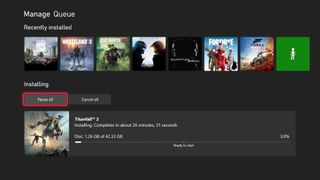
Your internet reliability and download bandwidth caps are going to dictate how quickly you can download games, though you really feel the rising size of game sizes when you're facing an empty hard drive. Be it through backwards compatibility or Xbox Game Pass, there's a massive library of available games and you'll want to pick your battles on day one wisely. Don't think that those of you with physical media are in for an easier ride, either; disks take as long to install on Xbox Series X as they did for Xbox One, so expect to wait anywhere between 20-50 minutes for installation before the inevitable patch requests kick in. And, no, you still can't download multiple games or updates simultaneously, nor can you easily shift them around in the install queue.
Customisation runs deeper than the dashboard and the Guide and there is a wealth of options available through the Settings application; while you're waiting for all of your games to download, install, and update, it would be wise to dive in. The controller can be remapped at a system level to create defaults for thumbstick inversion and the functionality of the triggers, share, and face buttons. Privacy and parental settings are easy to control and leverage, there's a wealth of display and audio settings to tinker with, and it's well worth dialling in the types of notifications you receive from Xbox Live. While some of the options are buried in sub-menus, a holdover from the App-based design of the original Xbox One, the Xbox ecosystem remains incredibly flexible and customizable.
XBOX SERIES X XBOX LIVE
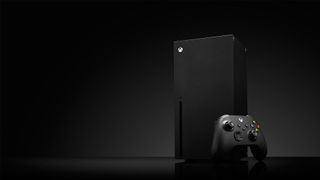
Xbox Live has always been the backbone of the Xbox ecosystem and a new generation would traditionally introduce new innovations to the service. Last generation, Microsoft used the Xbox One launch to raise the friends list from 100 to 1000, made a number of quality-of-life improvements, and built a 'Smart Match' system that sought to improve matchmaking. Given how closely the Xbox Series X is intertwined with the Xbox One in service of forwards and backwards compatibility, we aren't seeing the same degree of innovation or evolution. Everything has to be consistent across both generations, and across platforms encompassing PC and Android devices thanks to xCloud and Remote Play.
Microsoft's decision to integrate universally-synced cloud saves – complete with automatic saving and unlimited storage – with Xbox Live back in 2013 has proven to be one of the best decisions the company has ever made. Turn on your Xbox Series X, sign-in to your Live account, and everything is there. Your digital licenses, achievements, your profile and preferences, and, more importantly, all of your save data too. Xbox Series X backwards compatibility takes on a new dimension because of cloud saves, and so it's no surprise that Sony is implementing something similar for PS5, letting you move your PS4 save data over to the new console. A clear advantage of this connected Xbox ecosystem, however, is in the ability to load up a 15-year-old game only to find your save data waiting for you… honestly, it feels like you're witnessing magic in action.
The biggest change to Xbox Live surrounds game capture and streaming, an area Microsoft trailed behind Sony for an entire generation. The Xbox Series X controller features a Share button, meaning you no longer need to mess around in the Guide to capture screenshots and video clips. The Xbox Series X is capable of capturing 4K resolution screenshots, as well as streaming gameplay and recording clips in 4K and at a framerate of 60 frames per second. The Xbox One's Game DVR launched with a cap of 720p at 30fps, while the One X could just about manage 4K at 30, so this is a massive step up. Oh, and better still there's no more sifting through OneDrive or Upload Studio to get captures off your console and onto social, everything is beamed straight to the Cloud and will appear within the Xbox App on your Smartphone within seconds.
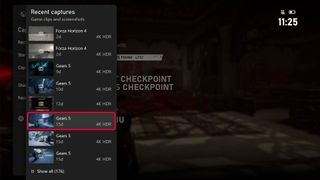
With the Xbox Series X wired into the broader Xbox ecosystem, you'll find that there are no new restrictions on who you can play with, party with, or send messages to. Xbox Live recognises Xbox Series X as another console on the network and, as a result, I haven't experienced any problems jumping into rounds of Fortnite or Call of Duty: Warzone with Xbox One and PS4 players, nor did I notice any problems or disadvantages when playing Gears 5 multiplayer at 120fps with Xbox One players who are locked to 60fps.
When it comes to Xbox Live on Series X, it's all about small quality-of-life improvements, rather than sweeping updates or upgrades. The store is probably the most notable change, having been overhauled as part of the New Xbox Experience; it's cleaner and easier to use, and faster to find what you're looking for and increases the visibility of a wider range of products and services. Despite its familiarity, Xbox Live remains a phenomenal service. Multiplayer is smooth and secure, it's easy to party up and communicate with friends, and services such as Xbox Game Pass remain unparalleled in terms of accessibility and affordability.
XBOX SERIES X ENTERTAINMENT
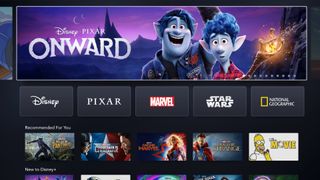
Microsoft understands that acting as an all-encompassing entertainment portal is a redundant ambition in 2020. This is a console designed to be played through new 4K televisions, and few of those are going to come without robust, built-in support for Smart TV and entertainment applications. The loss of support for HDMI-In makes OneGuide redundant. As Kinect stirs six feet under, so too does the need to beg and plead with your Xbox to pause a show. In an age where the use of second-screen devices is ubiquitous and so the Xbox One's Snap functionality – the ability to run an app or watch television side-by-side with a game – was removed from the OS back in 2017, and no picture-in-picture solution has been re-introduced for Series X.
Instead, the Xbox Series X keeps it simple and comes loaded with just about every application that you could need. There are over 28 entertainment apps available through the store, so if any of your favourites are missing on Xbox One they will be missing here too. Media control for 4K UHD, Blu-Ray, and DVDs also shares the same underlying architecture with the Xbox One player, which is to say that it is functional and inoffensive. While the console is quiet in just about everything that it does, expect to hear a little bit of noise when using physical media as the disk drive whirrs into action.

The Xbox Series X will also let you load up your OneDrive account and view external media from there, and it also supports playback from a USB storage device and media streaming from PC via DLNA should you download the free Media Player app. Music can still be played in the background of the dashboard and in-game from supported apps, such as Spotify; music can be controlled from the Guide, as can specific settings such as the rebalancing of game audio to your own music.
If there's any major failing of the entertainment experience on Series X, it's that Quick Resume does not extend to media. If you're watching a show on Disney Plus or a movie on Netflix, for example, they won't suspend in place should you decide to switch your attention to a game and then back again. While it's fast enough to resume playback, it would have been nice to pick straight back up from where you left off with entertainment, just as you're able to do with games. Still, this frustration aside, the Xbox Series X is a capable entertainment hub – it just isn't the focal point of the entire experience.
XBOX SERIES X BACKWARDS COMPATIBILITY

The Xbox Series X has a custom processor with eight AMD Zen 2 CPU cores, and a 12 Teraflop RDNA 2 GPU. That pairing means that the console can target performance of eight times the original Xbox One and twice that of the Xbox One X, with the new Xbox Series X able to execute games at a native 4K resolution and at 60 frames per second with little compromise. There are few new games at launch that will truly take advantage of this power, and so it's, the way the powerful CPU can work in tandem with the SSD to automatically enhance backwards compatible games that will reflect the most obvious next-generation upgrades.
The Xbox Series X has full backwards compatibility for Xbox One games, and it supports any Xbox 360 and original Xbox titles that worked on that system too. Legacy titles run natively on Series X, which means that the thousands of available games automatically benefit from performance of CPU and SSD. Every game I have tested has seen significant reductions in load times – lowering by as much as 70% in some cases. Typically, games run smoother, enjoy steadier framerates, and more stable transitions between the action and menu-based admin.
That's all to say that the Series X is able to cast many of your favorite games – the cross-gen multiplayer games that are still in your rotation, in particular – in an entirely new light, and all without any direct optimisation from developers. It means games like Apex Legends, Destiny 2, and The Outer Worlds automatically benefit from the power of the hardware, holding steadier frame rates during moments of frantic action, loading in and out of menus without hitching, and loading between zones far faster than you'd have seen on Xbox One or Xbox One X. You can even look back to something like 2008's GTA 4 for Xbox 360, which is also able to double its frame-rate from a once unstable 30fps to a locked 60fps.
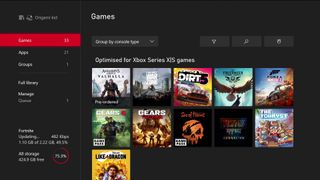
The titles that were treated to performance-enhancing patches for Xbox One X have even greater gains. You can look at a performance heavy game like Fallout 4 and find that its frame rate has leaped from 30fps to 60fps, Meanwhile, titles like Final Fantasy 15, Monster Hunter World, and Rise of the Tomb Raider are finally able to run at locked 60fps in their High FPS, Lite, and Resolution modes. Broadly, we're seeing that games are able to realise their true potential now, after languishing within the constraints of Xbox One hardware for a generation.
Truth be told, the Xbox Series X has cast the entire Xbox One generation in a new light, and the free gains offered by the Xbox Series X makes an Xbox Game Pass subscription feel more necessary than ever before. It's made returning to the past a real pleasure. More impressive still is the implementation of Auto HDR across the back catalogue. Microsoft's machine learning algorithm is able to automatically add high dynamic range flourishes to existing titles, meaning that those of you with a 4K HDR-compatible television are about to find that your older games look better than ever too.
If Microsoft's backwards compatibility efforts show anything, it's that we're about to see a huge shift in developers prioritising framerate over resolution, or at least giving consumers the opportunity to choose. The Xbox Series X is powerful enough to lock the games that pushed the boundaries of the previous generation in at their intended framerates and the results are truly impressive. That instils great confidence in what will come down the line for Series X: games that are faster, smoother, and more stable than in any console generation before it.
XBOX SERIES X GAMES

It's perhaps indicative of the position that Microsoft is in that the best showcase of the Xbox Series X is a console exclusive released in 2018. There's a Halo Infinite-shaped hole in the launch lineup, and so it's been left to the first-party studios to fill the gaps in the library. Forza Horizon 4 is the clear standout, optimised for Series X to run in 4K at 60fps, and it's truly stunning. It is not only able to demonstrate what types of experiences we should expect from this console, but it highlights just how needed the Series X is for developers – straining to create the best games that they could within the constraints of the Xbox One and One X hardware.
I've been similarly impressed with the optimisation efforts on Sea of Thieves (2017) and Gears 5 (2019), titles that again look and play better than any console player imagined they could. Gears 5 is particularly impressive, not just because of its 4K at 60fps campaign configuration, but because of its offering of 120hz multiplayer sessions. Dirt 5 – one of the few third-party games that were provided for testing – similarly offers the option for racing at 120fps, dropping the resolution to 1440p to accommodate.

It's difficult to quantify just how impactful this focus on frame rates truly is. In many respects, it feels a little nebulous – something to be experienced, rather than read about. But I'm going to give it my best shot by saying that games just feel better; they are smoother and more responsive, and you'll certainly notice it when you go back to a 60fps game or (heaven forbid) 30fps. It isn't that you can visually recognise the leap from 60 to 120, but you'll notice that input lag is noticeably reduced. It feels as if you have full control of the avatar in front of you – be it a supercar burning rubber or a super-soldier slamming into waist-high cover.
The Optimised for Series X games give us a glimpse into a future where games don't necessarily look all that much better from what you may have experienced on Xbox One X, but they certainly play better. Of course, frame rates are just a part of that – the SSD working in tandem with the unique Velocity architecture of the Series X means loading times are reduced even more significantly than standard backwards compatible titles. Everything feels faster and less sluggish, be it messing around with loadouts in-game menus or shooting an enemy in the face. This is a future we should all want to see and be immersed in, the question is how long will it take developers to seize it.
XBOX SERIES X FINAL THOUGHTS

The Xbox Series X is an unconventional next-generation console. It's arriving with thousands of playable games from day one, each of which appears to play better than they ever have on console, but the broad appeal of that offering will likely depend on where your allegiances have been for the last generation.
If you're returning home to Xbox after seven years with the PS4, I don't think you'll be disappointed. Forza Horizon 4, Gears 5, and Sea of Thieves might be older titles, but with their optimisation for Xbox Series X, they look and feel as if they could have released yesterday. Similarly, other exclusives that are yet to receive optimisation patches – Ori and the Will of the Wisps and Halo 5: Guardians, for example – play wonderfully, as do games like Quantum Break and Rare Replay that were initially optimised for One X and are receiving huge free gains on the new hardware. If you're new into Xbox, there's plenty here for you to play.
If you're coming into Xbox Series X from within, upgrading from an Xbox One, One S, or One X, then you'll immediately feel the benefits of the new system, but I anticipate that some will feel a little disappointed by the lack of anything truly brand new from the first-party studios that can act as a system showcase to justify the high price of entry as an early adopter. In a world where many of us are spending more time than ever before replaying the same games nightly – Apex Legends, Destiny 2, GTA Online, Fortnite, and Warzone, for example – perhaps that doesn't matter as much as it would have in previous generation cycles. For now, the Xbox Series X offers the best place to play for Xbox owners. Only you can decide if that's enough right now.
Still, it's easy to be impressed with the Xbox Series X. It's a powerful and capable machine that sets Microsoft up for the future. What it lacks in a clear system seller, the Xbox Series X regains some ground with a number of key quality-of-life improvements. Between the massive reduction in load times, the ability to push games at a stable 60fps at 4K, and a number of improvements to existing games through backwards compatibility, the Series X has removed so much friction from the Xbox ecosystem. In many ways, it feels as if Microsoft is looking beyond November 10 with the Xbox Series X. It's clear that this is a system set up for future evolution, iteration, and success. The Xbox Series X is a great gaming console with only a few games on the immediate horizon designed to take full advantage of it.

Josh West is the Editor-in-Chief of 12DOVE. He has over 15 years experience in online and print journalism, and holds a BA (Hons) in Journalism and Feature Writing. Prior to starting his current position, Josh has served as GR+'s Features Editor and Deputy Editor of games™ magazine, and has freelanced for numerous publications including 3D Artist, Edge magazine, iCreate, Metal Hammer, Play, Retro Gamer, and SFX. Additionally, he has appeared on the BBC and ITV to provide expert comment, written for Scholastic books, edited a book for Hachette, and worked as the Assistant Producer of the Future Games Show. In his spare time, Josh likes to play bass guitar and video games. Years ago, he was in a few movies and TV shows that you've definitely seen but will never be able to spot him in.
